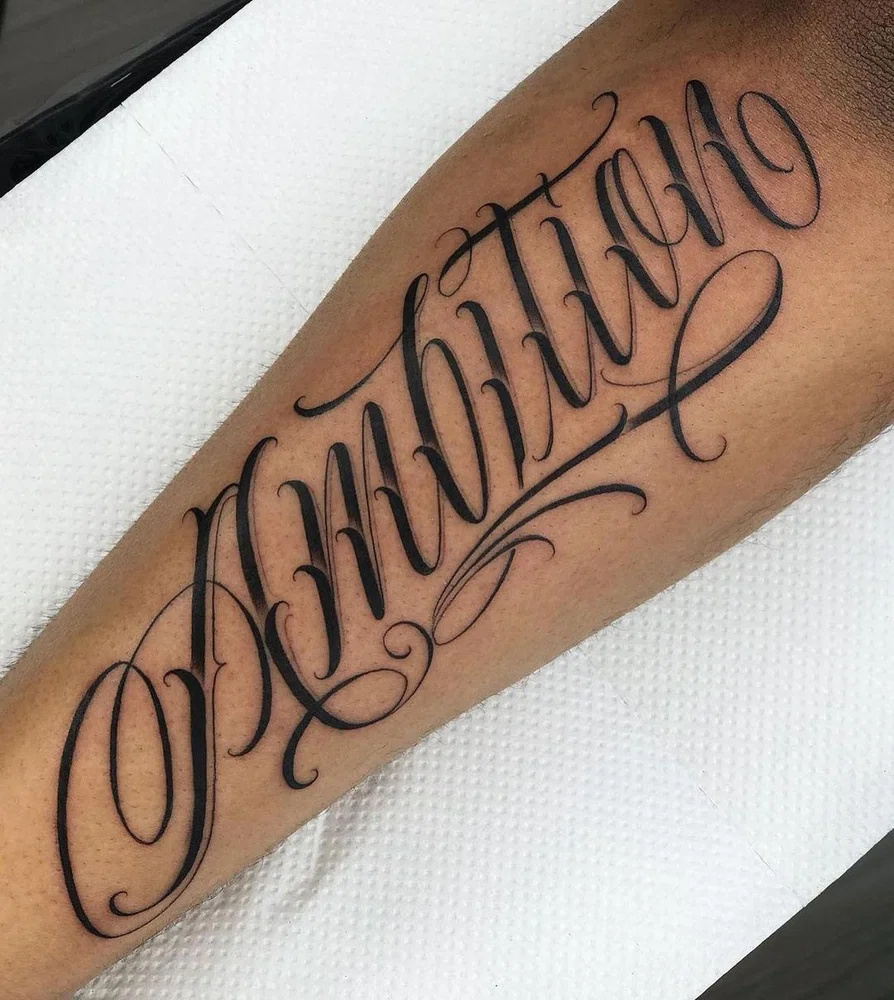Tattoo lettering is a highly sought-after resource among artists who seek to experiment with new techniques.
This specialized approach is focused on creating lettering with unique and original designs, enabling artists to tattoo not only a phrase but also a concept and a creative idea.
While there are numerous lettering styles to choose from, the fundamental principles remain the same. To ensure that tattoo lettering is executed to the best of its potential, we have compiled a list of essential tips and tricks.
What is lettering?
The term “lettering” refers to the art of crafting lettering uniquely, typically with a great deal of detail and curves. It is often described as the art of drawing letters.
While writing is done mechanically and almost automatically, lettering involves a more creative process. With lettering, one must sketch and visualize an appealing result, which sets it apart from writing.
Originally, a resource within graphic design, lettering has expanded to the art of tattooing. To ensure the successful execution of tattoo lettering, it is important to revisit some basic design principles and utilize the best tools available.
The importance of calligraphy
While lettering involves the art of drawing letters, calligraphy is the art of writing letters.

This distinction is crucial, as it highlights the difference between creativity and strict adherence to form. In lettering, the artist has the freedom to express their artistic vision, whereas calligraphy requires discipline, precision, and adherence to strict guidelines.
Each calligraphy style has its own unique characteristics, making it essential for artists to learn the basics and experiment with various stroke techniques. We recommend mastering the basic patterns of each style by practising on paper and synthetic skins specifically designed for tattooing. Click here to learn more Synthetic skins for tattooing.
Experimenting with different sizes, fonts, and styles is also crucial in developing your own lettering tattoo style. This approach can help you create unique designs that stand out from the rest.
Design your own fonts
The internet and social networks are flooded with countless font options, making it seem like the possibilities are endless. However, when it comes to classic tattoo styles, there are a few popular choices worth noting.
Firstly, we have gothic and cursive lettering, followed by the classic Traditional tattoo typography. While graffiti lettering used to be popular, it has fallen out of fashion in recent years.
Although many websites offer fonts, and some even do so for free, we advise against using them for your tattoos. Just as we discourage using generic designs from the internet, we also recommend creating your own unique lettering style. This ensures that your tattoo is one-of-a-kind and truly reflective of your individuality.
It is always better that you stand out with a personal lettering style.
Our advice is to practice conventional lettering styles and gradually perfect them in your own unique way by adding your personal touch.
If you're unsure how to achieve this, we recommend reading our article on How to create your tattoo style?
As previously mentioned, practising calligraphy on paper is crucial to develop your pulse and strokes. However, for a more creative approach, you can use software like Procreate, which is a popular choice among tattoo artists for designing their tattoos. This software allows you to create in a more practical and efficient manner, making the design process more agile and effective.
Considerations when tattooing lettering
As we've discussed, lettering is a complex art form, and the same goes for lettering tattoos. Precision is key, making it unsuitable for beginners.
Every line and curve must be executed precisely as shown on the template. Even a minor deviation could ruin the entire design, so it is crucial to be meticulous in your execution.
Additionally, fine needles are often used, making it even more critical for experienced tattoo artists to take on this type of work.
In lettering tattoos, it is customary to create only lines and avoid tattooing the same area twice. This approach requires a skilled hand to get it right, which is why it's recommended for experienced tattoo artists to take on this type of work.
The size of the letter is a crucial aspect of lettering tattoos.
The design should have a good proportion between the size of the letter and the size of the tattoo. If the font size is too large, it may not fit the area of the body you are tattooing, and if it's too small, it may be hard to read. Therefore, it's essential to measure the size of the design before starting the tattooing process.
Creating lettering tattoos is not an easy task and requires a lot of attention to detail. Rushing the process is futile, as neatness is vital to achieving the desired results. It is essential to take your time, concentrate, and practice as much as possible.
In conclusion, lettering tattoos may look simple, but they are some of the most challenging designs to create. Practising on paper, digitally, and synthetic skin before tattooing your client is necessary. Remember, practice makes perfect.
Did you know about Lettering tattoo? Do you want to learn new techniques?
Discover our tattoo courses where specialized professionals provide you with all their knowledge and experience.